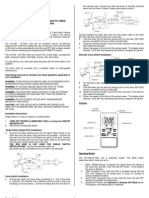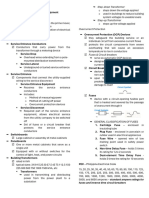Time Lag Switch
Time Lag Switch
Uploaded by
Sravan SimhadriCopyright:
Available Formats
Time Lag Switch
Time Lag Switch
Uploaded by
Sravan SimhadriCopyright
Available Formats
Share this document
Did you find this document useful?
Is this content inappropriate?
Copyright:
Available Formats
Time Lag Switch
Time Lag Switch
Uploaded by
Sravan SimhadriCopyright:
Available Formats
PRODUCT DATA AND INSTALLATION SHEET
490-194 AND 279-8614 DESCRIPTION AND OPERATION
ELECTRONIC TIME LAG SWITCHES These time lag switches are a quick and effective way to reduce energy
consumption for lighting applications. Pressing the button brings the lights
on; the lights will then switch off automatically after a preset time period
has elapsed.
These units do not require a neutral connection, therefore they can be
used to replace an existing light switch. The duration of the time delay is
set by a thumbwheel on the reverse of the unit.
The switches comes with extra terminals to allow slave switches to be
connected to the system to trigger the timer.
The 279-8614 product has an illuminated push button to allow the unit to
be located in the dark.
Time lag switches can be used in two way and intermediate switching
arrangements without any extra wiring.
WIRING INSTALLATION
Conventional Wiring Warning. This device works at mains potential. Be sure to take care when
working with electricity.
Wire the units as in diagram 1. When using multiple switch posi-
1. Make sure the load is connected and in working order.
tions see diagram 2.
2. Isolate the mains supply to the circuit at the main consumer unit.
3. Connect the controller via the terminal block. Live supply to the L
For two way and intermediate switching follow the diagrams over-
terminal and the load to the LIVE OUT terminal.
leaf. Note that as long as each switch position has a Live feed
4. Connect the slave switches if using.
and a Live Out connection to the load then the switch will be
5. Set the timing range using the thumbwheel. Turn clockwise to
properly wired.
increase timing.
6. Screw the unit to the wall and switch the mains supply back on at
Using Slave Switches
the distribution board.
7. Wait 20 seconds before pushing the button
Where slave switches are used follow diagram 3. Limit the cable
8. Push the button and the lights will come on
run between the slave switches and the timer to 25m.
9. Wait for the time period and the lights will turn off again.
Note that the slave switch must connect directly to the terminals.
Putting Live, Neutral or Earth on the terminals will damage the
unit.
Slave switches with integral neons will only work if the neons are
supplied separately with a Live and Neutral connection.
Diagram 1 Diagram 3
Conventional Slave switches
wiring
Diagram 2
Multiple switch
locations
Ref %WD049 Issue 2
FAULT FINDING SPECIFICATION
LIGHTS DO NOT COME ON LOAD
Check to see if the live supply to the circuit is 10 Amp incandescent lighting
good. Strap across the L and LIVE OUT termi- 6 Amp fluorescent lighting
nal to turn the load on. 3 Amp compact fluorescent lighting
3 Amp low energy lighting
LIGHTS DO NOT GO OFF 3 Amp low voltage lighting (switch primary of transformer)
Fluorescent lighting (max 6 fittings recommended)
Ensure that you have waited for the time out Most fluorescent fittings have power factor correction capacitors fitted. If they are not present
period. the unit may fail to turn off properly or flicker. In this case fit one capacitor per circuit with a mini-
mum value of 1 F for every timer installed. The capacitor should be fitted across switched live
If the lights still do not go off then it is likely the and neutral. Note that it is not necessary to fit a capacitor on every fitting. This also applies to
unit was not given the 20 seconds start up pe- fittings controlled with high frequency ballasts and maintained emergency fittings.
riod on installation. Follow this procedure:
1. Isolate the mains supply to the circuit at For fluorescent lighting total power factor correction capacitance must not exceed 40 F.
the main consumer unit and unscrew
the unit from the wall. Not suitable for switching contactors
2. Turn the lights off by tapping the relay Not suitable for SON lighting
on the rear of the unit with the handle of Not suitable for heating or ventilation loads.
a screwdriver until the contact opens. Please contact our sales department for a suitable alternative product.
3. Reapply the mains and wait for 20 sec-
onds. SUPPLY VOLTAGE 220-240 Volts AC 50 Hz
4. Push the button for operation. TIME OUT PERIOD 20 seconds to 20 minutes (approximate)
FIXING METHOD Surface fixing 25mm deep plastic surface mount moulded box.
LIGHTS FLICKER Flush fixing 25mm steel wall box or 32mm deep cavity wall box.
TERMINAL CAPACITY 1.5mm2
Ensure that there are sufficient power factor MATERIAL Flame retardant ABS
correction capacitors fitted. TYPE Class 2
TEMPERATURE -10°C to 35°C
CONFORMITY EMC-89/336/EEC
LVD-73/23/EEC
PART NUMBERS
490-194 Electronic time lag switch
279-8614 Electronic time lag switch with neon locator
IMPORTANT NOTICE! Due to our policy of continual
product i mprovement CP
This device should be installed by a qualified electrician Electronics reserves the right to
in accordance with the latest edition of the IEE wiring alter the specification of this
regulations. product without prior notice.
Ref %WD049 Issue 2
You might also like
- Hunter Universal Fan & Light Remote Control Model 27185: Wiring DiagramDocument1 pageHunter Universal Fan & Light Remote Control Model 27185: Wiring DiagramDhana RajNo ratings yet
- REBT in A Nutshell - Neenan, Dryden PDFDocument99 pagesREBT in A Nutshell - Neenan, Dryden PDFIqbal Baryar100% (9)
- PIIMA - Presidential School Presentation (26 May - Tashkent - Edu Track)Document11 pagesPIIMA - Presidential School Presentation (26 May - Tashkent - Edu Track)johndavsg8022No ratings yet
- Swylite LST100 Instruction SheetDocument2 pagesSwylite LST100 Instruction Sheetgreen8019No ratings yet
- 63A Series Transfer Switch User ManualDocument1 page63A Series Transfer Switch User ManualOgie SeptiawanNo ratings yet
- Swylite LST200 Instruction SheetDocument2 pagesSwylite LST200 Instruction Sheetgreen8019No ratings yet
- Swylite LST700 Instruction SheetDocument2 pagesSwylite LST700 Instruction Sheetgreen8019No ratings yet
- Emp600stv SchaltplneDocument4 pagesEmp600stv SchaltplneAlexandre PartzovNo ratings yet
- Ngcngci 6 DLHG 2 Ciiqwj 6Document5 pagesNgcngci 6 DLHG 2 Ciiqwj 6Dima NajiNo ratings yet
- SYMBOLDocument18 pagesSYMBOLBrother ElyNo ratings yet
- Eng B1ee Ermes NewDocument16 pagesEng B1ee Ermes Newlrewar37No ratings yet
- F24 60 en (A4) V1.2Document2 pagesF24 60 en (A4) V1.2dozer_kamilNo ratings yet
- Intermatic EJ351 Light Switch TimerDocument2 pagesIntermatic EJ351 Light Switch TimersuperadoeNo ratings yet
- Meeting Amplifier: WA-641 WA-641CDocument15 pagesMeeting Amplifier: WA-641 WA-641CLuis EcheverríaNo ratings yet
- MLS2000 UgDocument121 pagesMLS2000 UgIbrahim AbdElHamidNo ratings yet
- Product Data and Installation Sheet Elt10 E L T S: Mergency Ighting EST Witch D ODocument2 pagesProduct Data and Installation Sheet Elt10 E L T S: Mergency Ighting EST Witch D OGerardo ColmenaresNo ratings yet
- Parts and Function of MicrowaveDocument5 pagesParts and Function of MicrowaveManuel Panotes Reantazo50% (2)
- Eaton Emergency Lighting Self Contained Safety Ip65plus Manual enDocument2 pagesEaton Emergency Lighting Self Contained Safety Ip65plus Manual enJuan Carlos Gomero ChayanNo ratings yet
- Manual CRT SS9900 ENG PDFDocument20 pagesManual CRT SS9900 ENG PDFSaimonKNo ratings yet
- IS0287A01MMDocument80 pagesIS0287A01MMTomica BajicNo ratings yet
- DL 8171 - Electropneumatic Support Module - INGDocument8 pagesDL 8171 - Electropneumatic Support Module - INGKamanziNo ratings yet
- A Single Phase Smart Energy Monitoring System Using Labview: Sakshi Singhal, Amit Giri, Shruti SrivastavaDocument5 pagesA Single Phase Smart Energy Monitoring System Using Labview: Sakshi Singhal, Amit Giri, Shruti SrivastavaLokesh Krishna SagiNo ratings yet
- Cebek I 208 User ManualDocument4 pagesCebek I 208 User ManualAbu Bakr M. SaeedNo ratings yet
- Relative Volatility& Equlibrium DataDocument4 pagesRelative Volatility& Equlibrium DataAqib Amir HansuwNo ratings yet
- Two Way Switch Circuit A Comprehensive GuideDocument9 pagesTwo Way Switch Circuit A Comprehensive Guide2- ana lucia cruz lainezNo ratings yet
- Lesson Content ImageDocument38 pagesLesson Content ImageHiran Shanuka SamahonNo ratings yet
- Power System - Ii Lab Manual (EE-328) Vi Semester Electrical EngineeringDocument22 pagesPower System - Ii Lab Manual (EE-328) Vi Semester Electrical EngineeringRahul DuttaNo ratings yet
- 179 Manual Tesla Smart Switch Zigbee DualDocument122 pages179 Manual Tesla Smart Switch Zigbee DualpabloleonardiNo ratings yet
- Slide No. Slide Content Voice Over: ( (VIDEO:13018) ) + P.15.3.2Document4 pagesSlide No. Slide Content Voice Over: ( (VIDEO:13018) ) + P.15.3.2Gaurav JainNo ratings yet
- Psu Iii LedDocument3 pagesPsu Iii LedRobert KlevenNo ratings yet
- Es 9078Document6 pagesEs 9078acmaraviveNo ratings yet
- Samsung L70a Aquamarine Chassis Hl67a750a1fxzc DLP Projectio (ET)Document99 pagesSamsung L70a Aquamarine Chassis Hl67a750a1fxzc DLP Projectio (ET)Dan PrewittNo ratings yet
- ActivitiesDocument17 pagesActivitiesSan jayNo ratings yet
- Pni Svm-10K/ Pni Svt-10K: Voltage Stabilizer / Stabilizator de TensiuneDocument19 pagesPni Svm-10K/ Pni Svt-10K: Voltage Stabilizer / Stabilizator de TensiuneDamir SuminaNo ratings yet
- Push Button Electronic Timer: 31VETR3Document8 pagesPush Button Electronic Timer: 31VETR3ZF ECTBNo ratings yet
- SG 1478k GTECDocument6 pagesSG 1478k GTECvishadmgsNo ratings yet
- Support Note: Contact Debounce Circuit For SwitchesDocument5 pagesSupport Note: Contact Debounce Circuit For SwitchesAk MarathiNo ratings yet
- vt-2 Ins Obs v10 GBDocument1 pagevt-2 Ins Obs v10 GBplennyNo ratings yet
- REsidential House WiringDocument8 pagesREsidential House Wiringdharan.v2006No ratings yet
- CQM1 Operation Manual 02Document10 pagesCQM1 Operation Manual 02วรพงษ์ กอชัชวาลNo ratings yet
- Inverter ManualDocument22 pagesInverter ManualhomesporefungiNo ratings yet
- RPLS530A/RPLS531A: ApplicationsDocument6 pagesRPLS530A/RPLS531A: ApplicationsErmiasNo ratings yet
- O&m SPVDocument9 pagesO&m SPVsingla.nishant1245No ratings yet
- Aspen Pumps Operation ManualDocument4 pagesAspen Pumps Operation Manuale-ComfortUSA100% (1)
- Installation and Operating Instructions Synchro-Check Monitor PLL/D-100/120, PLL/D-173/240, PLL/D-380/480, DIN-rail MountedDocument2 pagesInstallation and Operating Instructions Synchro-Check Monitor PLL/D-100/120, PLL/D-173/240, PLL/D-380/480, DIN-rail MountedAnonymous RcxX0FcNo ratings yet
- Grid Intertied InvertersDocument4 pagesGrid Intertied InvertersNOELGREGORIONo ratings yet
- Utilities 1Document4 pagesUtilities 1Dianna GwennNo ratings yet
- Computer Support and Maintenance AssignmentDocument6 pagesComputer Support and Maintenance Assignmentelvisnjoroge31No ratings yet
- Colony Counter SC6 Plus Instruction ManualDocument28 pagesColony Counter SC6 Plus Instruction ManualKenny LauNo ratings yet
- Section 6 - ElectricalDocument9 pagesSection 6 - ElectricalJonathanDavidDeLosSantosAdornoNo ratings yet
- 1KW-2KW Inverter Charger Quick GuideDocument22 pages1KW-2KW Inverter Charger Quick GuideJhulibeth RodriguezNo ratings yet
- PSQ 7Document10 pagesPSQ 7LarcierNo ratings yet
- Safety Information: Instruction ManualDocument6 pagesSafety Information: Instruction ManualJose luiz coelhoNo ratings yet
- Western Instruments WD Series Coils ManualDocument9 pagesWestern Instruments WD Series Coils ManualRino SutrisnoNo ratings yet
- Engineering Workshop Practices Lecture 5Document18 pagesEngineering Workshop Practices Lecture 5Mueen FaisalNo ratings yet
- Physics Activity Section ADocument5 pagesPhysics Activity Section AAnushka JaiswalNo ratings yet
- Manl 19486Document17 pagesManl 19486aliNo ratings yet
- PWM OC10A Rev0808Document5 pagesPWM OC10A Rev0808Patrizia Cudina100% (1)
- Manual BookDocument45 pagesManual BookAtaf AmirNo ratings yet
- Precaution PDFDocument6 pagesPrecaution PDFgilberto gutierrezNo ratings yet
- Samsung Pl42d5sx RCLDocument33 pagesSamsung Pl42d5sx RCLOscar RamirezNo ratings yet
- 12 Lead Ecg Application FormDocument2 pages12 Lead Ecg Application Formmuzammil1No ratings yet
- Guide Find Piano Sheet Music Youtube Link-1Document17 pagesGuide Find Piano Sheet Music Youtube Link-1Partituras VariosNo ratings yet
- ACH150X Course Study Notes (Precipitation Titrations) 2020Document8 pagesACH150X Course Study Notes (Precipitation Titrations) 2020Kgaugelo TraciaNo ratings yet
- The Stranger Stonetop PlaybookDocument3 pagesThe Stranger Stonetop PlaybookasfasdfNo ratings yet
- Alzheimer'S Disease 1Document10 pagesAlzheimer'S Disease 1api-288569056No ratings yet
- 7mm MauserDocument16 pages7mm MauserJohn Anderson100% (3)
- Final Revised Las in Science 9 q3w4Document4 pagesFinal Revised Las in Science 9 q3w4Ma.Kristine Ibarreta JazulNo ratings yet
- Medplus Ltd. (A), (B), (C) - UnlockedDocument7 pagesMedplus Ltd. (A), (B), (C) - UnlockedHimanshu BhanarkarNo ratings yet
- Wireless: CCNA Exploration Semester 3Document39 pagesWireless: CCNA Exploration Semester 3adityanandwaniNo ratings yet
- Cultural Issues SyllabusDocument24 pagesCultural Issues Syllabusapi-282188139No ratings yet
- Supply Chain MetricsDocument9 pagesSupply Chain MetricsjosefnuduNo ratings yet
- Manometer Tables: Recommended PracticeDocument54 pagesManometer Tables: Recommended Practicechristian camilo suarez rodriguezNo ratings yet
- FINAL COPY SHS 21st Century Literature Q1 M2 1Document28 pagesFINAL COPY SHS 21st Century Literature Q1 M2 1Michaella Dometita100% (1)
- DLL - Science 3 - Q1 - W8Document3 pagesDLL - Science 3 - Q1 - W8Rose Dagdag-Laguitao100% (1)
- Coffee ShopDocument84 pagesCoffee ShopHrdjjdNo ratings yet
- Foundry Workshop ManualDocument22 pagesFoundry Workshop Manuallakshya100% (1)
- Reproductive Health MCQs IDocument10 pagesReproductive Health MCQs IMahendhiran MariappanNo ratings yet
- Importance of PlagiarismDocument2 pagesImportance of PlagiarismTanvirul KhabirNo ratings yet
- 1034676.book of Proceedings 2018 1Document493 pages1034676.book of Proceedings 2018 1Klara PavićNo ratings yet
- Social Change: Characteristics and Factors: MeaningDocument27 pagesSocial Change: Characteristics and Factors: MeaningVenkata Vineeth100% (2)
- Materia Medica - MCQ - 3rd - BHMS - (2015)Document9 pagesMateria Medica - MCQ - 3rd - BHMS - (2015)Anil kadamNo ratings yet
- EduSkills-Internship-02-11-2024 domain list not applicableDocument2 pagesEduSkills-Internship-02-11-2024 domain list not applicables8ultejas001No ratings yet
- Project Manager Maneuver Ammunition Systems MAY (COL M. Gutierrez) PDFDocument9 pagesProject Manager Maneuver Ammunition Systems MAY (COL M. Gutierrez) PDFrobculNo ratings yet
- Group 3 - ChachaDocument20 pagesGroup 3 - ChachaNikelkel ShrimpNo ratings yet
- Baseline Assessment English Grade 9Document7 pagesBaseline Assessment English Grade 9desrescott100% (1)
- Anual Periodisation Notes: Preparatory Competitive TransitionDocument20 pagesAnual Periodisation Notes: Preparatory Competitive TransitionPMDGiraldoNo ratings yet
- Reading Sample: "Commerce" Index The AuthorsDocument26 pagesReading Sample: "Commerce" Index The AuthorsSoumak BanerjeeNo ratings yet
























































































